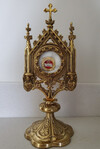Translation of the Relics of St. Dominic

We are shaped by our culture, and our culture is one that inherited a certain Protestant suspicion of relics, especially their veneration and use in worship. On top of that, as time went on, death itself became a more antiseptic affair. Bodies were embalmed or otherwise treated to avoid decomposition. Personally dealing with the body was usually seen as bit macabre, spooky, or for lack of a better word, “icky.”
But we have to remember our own Catholic tradition. Relics of the saints were treated with great veneration and honor. Our own Roman church spent much of its youth in the dark of the catacombs, with Masses celebrated, literally, underground, amidst and ON the saints. We keep a part of that tradition in the placing of saints’ relics on altar stones embedded in each altar. The priest kisses the altar, yes, but where the altar stone is or should be, not only venerating the saint, but above all Christ, who is Priest, Victim AND Altar.
In St. Polycarp’s Passion, we read of his martyrdom around the year 156, and how after his death, the Smyrnean Christians wrote that “we took up his bones, which are more valuable than precious stones and finer than refined gold, and laid them in a suitable place, where the Lord will permit us to gather ourselves together, as we are able, in gladness and joy, and to celebrate the birthday of his martyrdom.” The Church Fathers testify to similar events, and Saints Ambrose and Augustine themselves testify to the working of miracles in the presence of holy relics. Even in the Bible, we hear of miracles at the touching of a saint’s garment, at the shadow of a saint passing over a sick man, and a dead man coming to life when his corpse accidentally touches the bones of a holy prophet.
So we see a basis for the veneration of a saint’s relics, and Our Holy Father Dominic was no exception. St. Dominic himself wished to be buried, literally, under his brothers’ feet. The sick came to his tomb in our Dominican Church in Bologna, and many were healed. The friars at that time, however, were not exactly enamored of the idea of becoming a busy pilgrimage site. The pope, Gregory IX, prevailed on the friars to move the body of St. Dominic to a more proper and public place for veneration, and to examine the body as a first step for formal canonization.
This was no simple task. To touch a relic, to move a saint’s body, was considered a solemn task, even dangerous save for those clergy known for their own sanctity, and even they after fasting and prayer. As his body was transferred, a wonderful odor, often called “the odor of sanctity,” filled the Church, and all present gave thanks to Almighty God for this confirmation. This “odor” business may seem strange to us, but even St. Paul writes to the Corinthians, “But thanks be to God, who always leads us in triumph in Christ and manifests through us the odor of the knowledge of him in every place. For we are the aroma of Christ for God among those who are being saved and among those who are perishing, to the latter an odor of death that leads to death, to the former an odor of life that leads to life.”
So today we especially give thanks to God for this wonderful confirmation on the sanctity of Our Holy Father Dominic. We worship with him the One God, source of all Holiness. Blessed be God in His Angels and in His Saints!
From a homily by our former Director, fr. Dismas, OP
